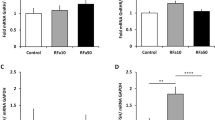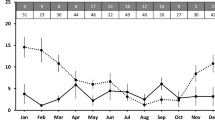Abstract
A HIGHLY significant seasonal variation in frequency of twin ovulations in Merino ewes was observed by Radford1. In order to determine whether this was correlated with seasonal variation in pituitary gonadotrophin content the surviving ewes from Radford's experiment were later killed—16 in mid-summer (January–February 1958) and 11 in mid-winter (June–July 1958). Each ewe was killed 14 days after œstrus.
This is a preview of subscription content, access via your institution
Access options
Subscribe to this journal
Receive 51 print issues and online access
$199.00 per year
only $3.90 per issue
Buy this article
- Purchase on Springer Link
- Instant access to full article PDF
Prices may be subject to local taxes which are calculated during checkout
Similar content being viewed by others
References
Radford, H. M., Aust. J. Agric. Res. (in the press).
Claringbold, P. J., and Lamond, D. R., J. Endocrinol., 17, 86 (1957).
Lamond, D. R., and Claringbold, P. J., J. Endocrinol., 17, 298 (1958).
Author information
Authors and Affiliations
Rights and permissions
About this article
Cite this article
LAMOND, D., RADFORD, H. & WALLACE, A. Bioassay of Sheep Anterior Pituitary Glands. Nature 183, 1597–1598 (1959). https://doi.org/10.1038/1831597b0
Issue Date:
DOI: https://doi.org/10.1038/1831597b0
This article is cited by
Comments
By submitting a comment you agree to abide by our Terms and Community Guidelines. If you find something abusive or that does not comply with our terms or guidelines please flag it as inappropriate.



